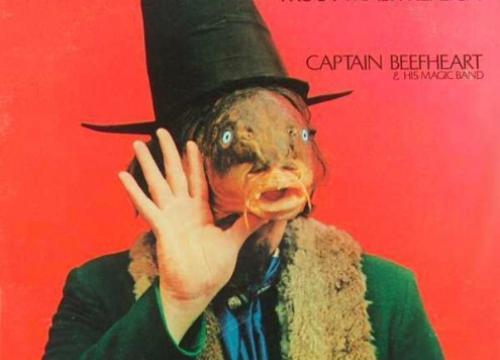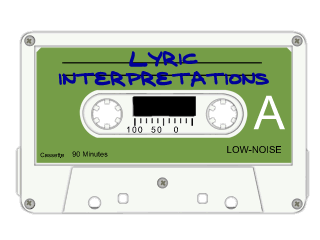The Weird, Weird, Weird Story of Trout Mask Replica

In recent years, you can't stumble into an Internet forum about indie music without bumping into Trout Mask Replica by Captain Beefheart. It's the ultimate hipster-cred album. Several forum denizens may have the album cover - Beefy himself in a pilgrim hat and fish mask waving from a red-to-fuchsia gradient background - as their avatar.
So is it that good? Oh, no no no. It is quite possibly the most cacophonous, dissonant, unlistenable album ever made. It is scary, grating, raving crazy, clashing and nonsensical and untuned and jangling. It sounds like it was run through a meat grinder. But every single note, beat, and syllable of every track of this album was intended to sound exactly as it does. Because, you see, this was science, not art. It is an experimental piece, amidst an experimental career, hosted by a musical scientist who was either mad, brilliant, or both, making research into music that we may not fully understand for another hundred years. But you probably shouldn't try dancing to it.
Yet, it was ranked #58 in Rolling Stone magazine's 2003 list of the 500 greatest albums of all time. Rock critic Lester Bangs called Beefheart "one of the four or five unqualified geniuses to rise from the hothouses of American music in the Sixties." John Cale of The Velvet Underground cited them as an influence. So did The Clash and the Sex Pistols and Gang of Four and Siouxsie and the Banshees. Oh, and don't forget Talking Heads, Blondie, Devo, and The B-52s. Comic artist Matt Groening (creator of The Simpsons and Life in Hell) is a raving passionate fan.
Frank Zappa produced it and even guest-performed on a track, which should tell you something right there. Captain Beefheart (born Don Van Vliet) frequently shared a stage with Zappa, and they had an on-and-off collaboration.
According to Beefheart himself: All of the songs were written in a single 8-hour session. His main compositional tool was a piano, which he had never used before. Songs were assembled haphazardly, piecemeal out of bits and phrases they liked. Then they were rehearsed with the insistence that they be played exactly the same way every time, and recorded in a professional studio. In that studio, the whole group jammed out the instrumentals in six hours flat.
Which is not to say that this process was easy on anybody. The group lived for 8 months in Beefheart's house in complete isolation, practicing 14 hours per day, with Beefheart berating and browbeating and even physically roughing up his motley crew, all while they had to live on welfare and donations from their families, which reduced them to living on a cup of beans a day for their sustenance. Drummer John French aptly described the atmosphere as "cult-like" and compared the house to Charles Manson's operation. You still love this album?
Well, you should listen to it. Here's how: the first time (do not use headphones), have it on a speaker somewhere softly, easy to ignore. Listen to it straight through three times, on three different days, just playing in the background. Now advance to individual tracks, replay the ones that intrigue you. Now put it away and don't think about it for a couple of days. This will be impossible, because individual lyrics and progressions will come back to haunt you. Impossibly, these decidedly uncatchy songs will get stuck in your head. Now come back and seek out those songs, again, that stuck with you. Now, at last, start listening to the album like you would normally.
Yes, it's a lot of trouble to go to, but if you want to be a member of a cult, you have to brainwash yourself a little. As the music sounds like it changes each time you listen to it, you will eventually discover that the album has changed the way you think about music forever. Good luck tolerating mainstream pablum after that!

 Buy the Soundtrack, Skip the Movie: Brainscan (1994)
Buy the Soundtrack, Skip the Movie: Brainscan (1994)  Let’s Go to the Hop - Ignore That Door’s Four Bunnie...
Let’s Go to the Hop - Ignore That Door’s Four Bunnie...  Forgotten Weird Music Videos of the Ancient 80s | vol 3
Forgotten Weird Music Videos of the Ancient 80s | vol 3  Forgotten Weird Music Videos of the Ancient 80s | vol 2
Forgotten Weird Music Videos of the Ancient 80s | vol 2  Forgotten Weird Music Videos of the Ancient 80s | vol 1
Forgotten Weird Music Videos of the Ancient 80s | vol 1  Let’s Chase Taylor Swift Rumors
Let’s Chase Taylor Swift Rumors  When the Beatles Touched Off a Movie War
When the Beatles Touched Off a Movie War  When Mike Bloomfield Composed a Soundtrack For Andy ...
When Mike Bloomfield Composed a Soundtrack For Andy ...  Yet Another List of Bad Song Covers
Yet Another List of Bad Song Covers  Why Does Everybody Pick On Liberace?
Why Does Everybody Pick On Liberace?  Trainspotting Soundtrack Revisited : One of the Best...
Trainspotting Soundtrack Revisited : One of the Best...  Nicki Minaj and Megan Thee Stallion: Bringing Back t...
Nicki Minaj and Megan Thee Stallion: Bringing Back t...  Quirky Songs About Los Angeles
Quirky Songs About Los Angeles  Penguin Pete’s Obligatory Penguin Cafe Orchestra Post
Penguin Pete’s Obligatory Penguin Cafe Orchestra Post  Heart | How Bad Are Those Animals?
Heart | How Bad Are Those Animals?  That Time Ronnie James Dio Saved Black Sabbath’s Bacon
That Time Ronnie James Dio Saved Black Sabbath’s Bacon  What is a Left Hand Path? - Entombed and Swedish Dea...
What is a Left Hand Path? - Entombed and Swedish Dea...  Song Analysis Corner: Convoy (1975)
Song Analysis Corner: Convoy (1975)  What’s Up With Margaritaville?
What’s Up With Margaritaville?  This Album Links Duran Duran, Andy Warhol, and Kurt ...
This Album Links Duran Duran, Andy Warhol, and Kurt ...  Your Back-To-School Playlist
Your Back-To-School Playlist  Cucumber Castle | the other Bee Gees Movie
Cucumber Castle | the other Bee Gees Movie  Danny Elfman Scores New Film; Other Movie Weirdness!
Danny Elfman Scores New Film; Other Movie Weirdness!  Sparks Is Not Crying in Their Latte
Sparks Is Not Crying in Their Latte  Travis Scott : Rapper, Cannabis Entrepreneur, Filmmaker
Travis Scott : Rapper, Cannabis Entrepreneur, Filmmaker  Anders Runestad – Author and Music Blogger
Anders Runestad – Author and Music Blogger  What If They Really ARE Giants?
What If They Really ARE Giants?  Prince’s Underrated Under the Cherry Moon
Prince’s Underrated Under the Cherry Moon  Six Degrees of Blondie
Six Degrees of Blondie  Six Degrees of: Adam and the Ants
Six Degrees of: Adam and the Ants  Discovering Beat-Club | Vintage West German Music Show
Discovering Beat-Club | Vintage West German Music Show  Eurovision Contest Winners part 2
Eurovision Contest Winners part 2  Song Analysis Corner: Snoopy vs. the Red Baron | The...
Song Analysis Corner: Snoopy vs. the Red Baron | The...  Eurovision Contest Winners part 1
Eurovision Contest Winners part 1  KISS SUXX!
KISS SUXX!  You Haven’t Met Your Last Reefer Man
You Haven’t Met Your Last Reefer Man  Ruth Underwood and the “Zappa sound”
Ruth Underwood and the “Zappa sound”  Catchy Commercial Earworms | vol 2
Catchy Commercial Earworms | vol 2  Song Analysis Corner: “Trouble Every Day” | Frank Zappa
Song Analysis Corner: “Trouble Every Day” | Frank Zappa  Blues Music For Your Great Recession
Blues Music For Your Great Recession  We Can Fix America If We Just Bring Back Schoolhouse...
We Can Fix America If We Just Bring Back Schoolhouse...  Song Analysis Corner: Istanbul (Not Constantinople)
Song Analysis Corner: Istanbul (Not Constantinople)  Music To Shoot Down UFOs To
Music To Shoot Down UFOs To  Are You Ready For AI Music?
Are You Ready For AI Music?  How Dreary Was 1970s Adult Contemporary?
How Dreary Was 1970s Adult Contemporary?  I Just Called To Say Stevie Wonder's Song Deserved a...
I Just Called To Say Stevie Wonder's Song Deserved a...  "Knock On Wood" | The Real Song To Remember From Cas...
"Knock On Wood" | The Real Song To Remember From Cas...  Dr. Dre's Not Gonna Take This Anymore
Dr. Dre's Not Gonna Take This Anymore  Apache - The Shadows | A Surf-Rock Safari
Apache - The Shadows | A Surf-Rock Safari  New Year : New Music Artists You (Probably) Haven't ...
New Year : New Music Artists You (Probably) Haven't ...  Song Odyssey | I Put A Spell on You
Song Odyssey | I Put A Spell on You  KMart and S.S. Kresge | Music Mystery?
KMart and S.S. Kresge | Music Mystery?  Did I Ever Introduce You To Horrorpunk?
Did I Ever Introduce You To Horrorpunk?  Song Analysis Corner : The Coffee Song
Song Analysis Corner : The Coffee Song  Duran Duran Finally Got Inducted
Duran Duran Finally Got Inducted  That Time Taylor Swift Broke Ticketmaster
That Time Taylor Swift Broke Ticketmaster  Parody Songs and Lawsuits | Of Interest To Aspiring ...
Parody Songs and Lawsuits | Of Interest To Aspiring ...  Worst Band Spats
Worst Band Spats  Rock and Roll Bookshelf | Corey Taylor's Seven Deadl...
Rock and Roll Bookshelf | Corey Taylor's Seven Deadl...  Lizzo, the Flute, and Racist-Sexist Republican Fallout
Lizzo, the Flute, and Racist-Sexist Republican Fallout 